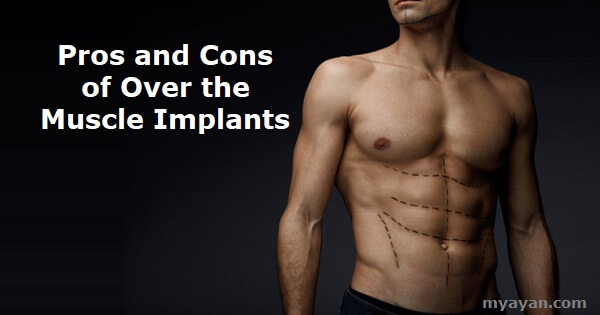A form of breast implant known as a muscle implant, often called a sub-glandular breast implant, is positioned over the chest muscle but beneath the breast tissue. It indicates that the implant is not positioned below the muscle but between the breast tissue and the chest wall muscle.
The surgeon will create an incision surrounding the areola or the crease beneath the breast during the surgical operation. The implant will then be inserted into the pocket before or behind the chest muscle.
Over-the-muscle implants are often advised for women with enough breast tissue to cover the implant and produce a natural-looking outcome. They could also be suggested for women who are physically active and partake in activities that require a lot of movement in the upper body, as positioning the implant above the muscle can lower the chance of issues associated with movement.They may be able to produce a more obvious increase in breast size than muscle implants, especially for women who already have smaller breasts. This type of implant may also have some drawbacks, such as a higher risk of visible rippling or wrinkling and a possibly higher risk of capsular contracture, a problem in which scar tissue forms around the implant and causes it to harden and possibly become painful.
The patient's specific anatomy, lifestyle, cosmetic objectives, and preferences will all play a role in the decision between over-the-muscle and under-the-muscle implants. After considering these variables, the best course of action for you should be discussed with a trained plastic surgeon.
Potential benefits of breast implants made of muscle include:
Compared to under-muscle implants, over-muscular implants do not need manipulation or stretching of the chest muscle during surgery. Therefore, the recovery period may be reduced.
Since the chest muscle was not damaged during surgery, patients who had over-the-muscle implants could have less discomfort during the first phase of their recovery.
A more pronounced cleavage may result because the implant is positioned nearer the skin's surface when placed over the muscle.
Bottoming out is a problem that can happen when the implant slips down and fills the lower pole of the breast excessively. This problem's likelihood may decrease by placing the implant above the muscle.
It's possible that women with large chest muscles won't have enough capacity to accommodate an implant. Over-muscle implants could be a preferable choice in certain circumstances.
On the other hand, it's vital to remember that over-the-muscle breast implants may also have drawbacks, including a higher chance of apparent rippling or wrinkling and a potentially higher risk of capsular contracture. The best course of action for you should be determined after discussing the advantages and disadvantages of this choice with a licensed plastic surgeon.
Compared to other breast implant kinds, such as submuscular implants, muscle implants, also known as sub-glandular implants, have several drawbacks.
With sub-glandular implants, the implant is positioned between the breast tissue and the chest muscle. Due to this location, the body may create a dense capsule of scar tissue around the implant that may harden and constrict, causing breast deformity, discomfort, and the requirement for revision surgery.
When implants are placed over the muscle, they may be more apparent and felt than when placed sub-muscularly, providing an artificial look.
The implant placement may make it more difficult to detect breast cancer during mammography, which might result in missed or delayed diagnosis.
Women with minimal natural breast tissue might not be good candidates for over-the-muscle implants because they may be more apparent and prone to rippling without the additional support of the surrounding muscle tissue.
Is increased by the weight of sub-glandular implants, which pulls down on the breast tissue and stretches the skin over time, causing further drooping of the breast tissue.
The advantages and disadvantages of each breast implant placement option should be discussed with your plastic surgeon to choose the one that will best serve your requirements and goals.
Conclusion
Breast implants are put over the pectoral muscles, but beneath the breast tissue are called over-the-muscle implants, also called sub-glandular implants.
While this technique has certain advantages, such as quicker recovery and reduced pain following surgery, there are also some disadvantages to taking it into account. Over-the-muscle implants might increase the likelihood of noticeable rippling or wrinkling in women with less breast tissue. Furthermore, this technique can obstruct mammography, making it more challenging to find breast cancer in the future. The final choice about muscle implants should be made after consulting with a trained plastic surgeon who can advise on the best course of action depending on each patient's needs and preferences.

Breast implants put over the pectoral muscle but beneath the breast tissue are called over-the-muscle implants, also known as sub-glandular implants.
An incision is made in the breast crease or around the areola to create a pocket for the implant during the operation, normally carried out under general anesthesia. After that, the implant is positioned over the pectoral muscle and beneath the breast tissue.
For women with sufficient breast tissue, the advantages of over-muscle implants include a quicker recovery time, less pain following surgery, and a more realistic-looking outcome.
Over-the-muscle implants have disadvantages, including a higher chance of noticeable wrinkling or rippling, especially in women with less breast tissue. Furthermore, this technique can obstruct mammography, making it more challenging to find breast cancer in the future.
The treatment typically takes 1-2 hours to complete.
Patients may suffer pain, swelling, and bruising throughout recovery, normally lasting between one and two weeks. Following the operation, patients are often recommended to refrain from vigorous exercise for a few weeks.
Infection, bleeding, implant rupture or leakage, capsular contracture, and changes in breastfeeding are among the potential risks and consequences of over-the-muscle implants.
The lifespan of over-the-muscle implants can range from 10 to 15 years, although they may need to be changed sooner if they burst, leak, or if the size or form of the breasts changes.